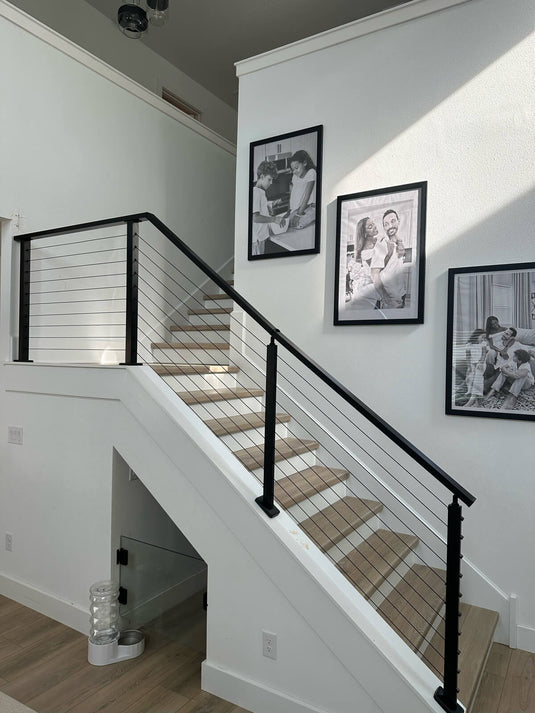TABLE OF CONTENTS
How Strong is Steel Cable Railing? Understanding Load Capacities for Safety
Steel cable railings have taken the design world by storm. It's easy to see why—they offer a clean, modern look that doesn't block your beautiful views. But as sleek as they are, a critical question always comes up: Is it actually strong enough? Can something that looks so minimal really be safe for my family?
This guide is here to clear up the confusion. We'll break down what makes a cable railing system so strong, the safety standards it must meet, and what you need to know to make sure your railing is as solid as a rock.

What Makes a Steel Cable Railing System Strong?
The first thing to get your head around is that the strength of a cable railing isn't just about the cable itself. It’s a complete system where every single part has an important job. If one part fails, the whole railing is compromised.
The star of the show is the stainless steel cable, usually made from Grade 316 steel. This grade is great at resisting rust, which makes it perfect for decks and patios. The most common type is a 1x19 construction, meaning one thick strand is made from 19 smaller wires twisted together. This design is very stiff and doesn't stretch much—exactly what you want. A single, thin 1/8" cable of this type has a breaking strength of over 1,700 pounds.
The cables are only as strong as the frame holding them up. The vertical posts are the backbone, taking all the tension from the cables and handling any direct impacts. These posts can be steel, aluminum, or wood, but they absolutely must be solid and installed correctly. A wobbly post or one just screwed to the top of a deck board won't cut it.
This is what brings it all together. Loose cables are floppy and useless. But when each cable is pulled tight—to around 200-300 pounds of tension—they form a stiff, web-like barrier that's incredibly resilient. Proper tension is what stops the cables from sagging and gives the railing its true strength.
Answering the Big Question: How Strong is Steel Cable Railing?
This is the main reason you're here. A properly designed and installed steel cable railing system is incredibly strong. It doesn't just meet the safety requirements in building codes; it often blows them out of the water.
To get specific, building codes (like the International Residential Code, or IRC) have clear rules for all guardrails. A railing must be able to handle two main forces without failing:
- A 200-pound concentrated force pushed in any direction on the top rail. This simulates a person falling against it.
- A 50-pound per linear foot uniform load pushed against the top rail.
For the cable section (the "infill"), the code says it must resist a 50-pound force pushed over a 1-foot-square area. Since a single 1/8" cable can handle over 1,700 pounds, and you have 10 or 11 of them running in parallel, the combined strength of the infill is massive and more than enough to meet this rule.
In short, when you install it the right way, your steel cable railing is a real-deal safety barrier, not just a pretty design feature.

Getting it Right: Critical Factors for a Strong Steel Cable Railing
You don't get that code-passing strength by accident. It all comes down to using good parts and, even more importantly, installing them correctly. Here are the things that make or break your railing's strength.
While 1/8" cable is the most common size for homes, you can also get 3/16" or 1/4" cable. These thicker cables have a much higher breaking strength. They provide an extra margin of safety and can feel more rigid, which is great for longer cable runs or on commercial projects where the rules are even stricter.
The distance between your posts matters a lot. If your posts are too far apart, the cables can flex more than you want them to. Most manufacturers recommend keeping your main posts no more than 4 to 5 feet apart to keep everything feeling tight and solid. Adding smaller cable braces between posts on long runs can also help a lot.
I can't say this enough: the best parts in the world are useless if they aren't installed right. Posts have to be bolted securely to the deck's frame (the joists), not just screwed to the surface boards. And the cables need to be tensioned to the manufacturer's specs. If the tension is too low, you'll have a saggy, unsafe railing. It's also normal to have to re-tighten the cables a bit a few weeks after the initial install as everything settles into place.
Is Steel Cable Railing Safe for Families with Children?

This is a common and very fair question. The main safety rule designed for child safety is the "4-inch sphere rule." Building codes state that no opening in a railing can be large enough for a 4-inch sphere to pass through. This is because a 4-inch gap is generally considered too small for a young child's head to fit through. As long as your cables are spaced no more than 3 inches apart and are properly tensioned, your railing will easily pass this test.
Some people also worry that kids might try to use the horizontal cables like a ladder. While it's something to think about, most building codes today do not forbid horizontal railings. If the "ladder effect" is a major concern for you, it's always smart to check with your local building department, just in case your town has its own specific rules.
So, there you have it. A steel cable railing is much stronger than it looks. Its real strength comes from the whole system working together: quality cable, a solid frame, and the right amount of tension. When you install it correctly, you get a safe, durable, and reliable barrier that will last for years. It’s a fantastic solution that proves you don’t have to trade a great view for peace of mind.




